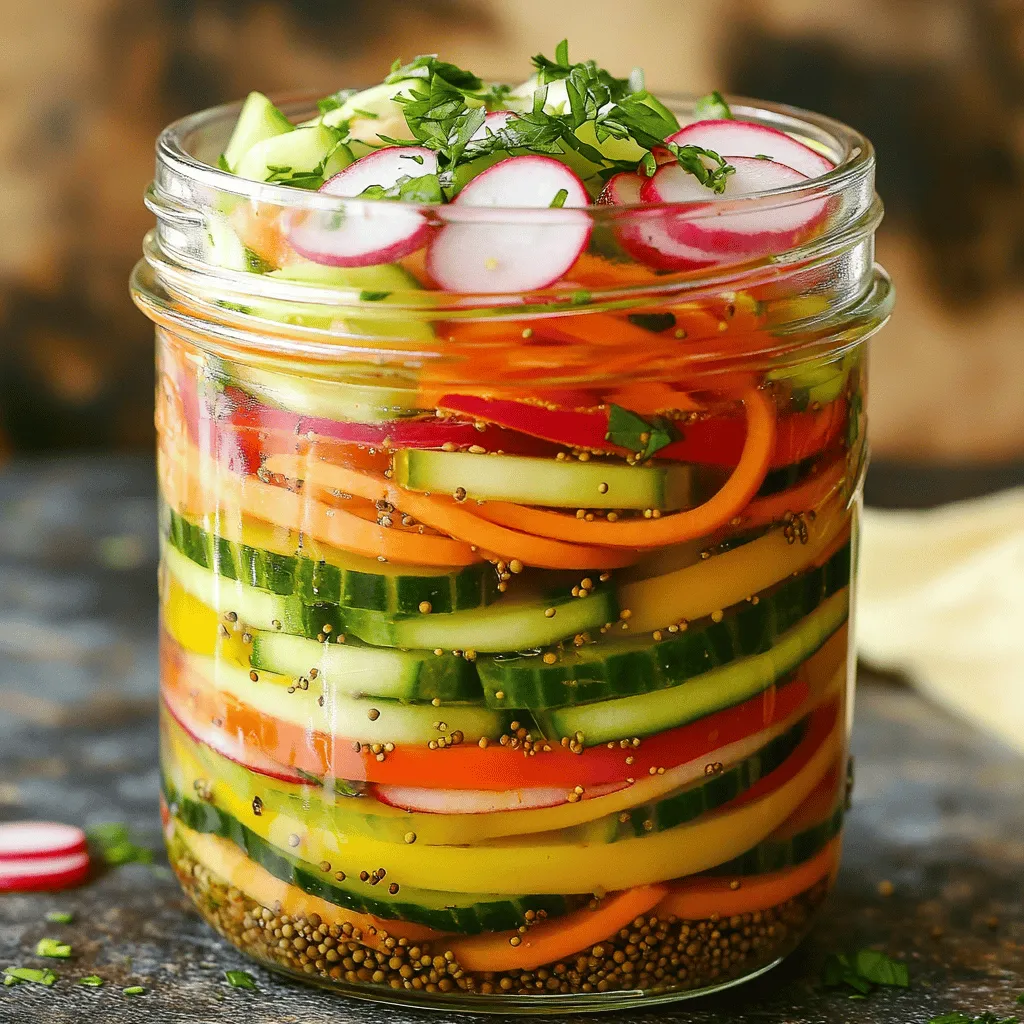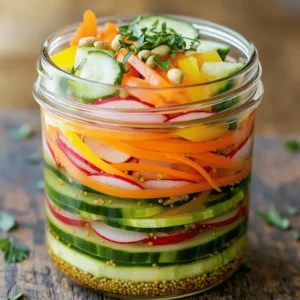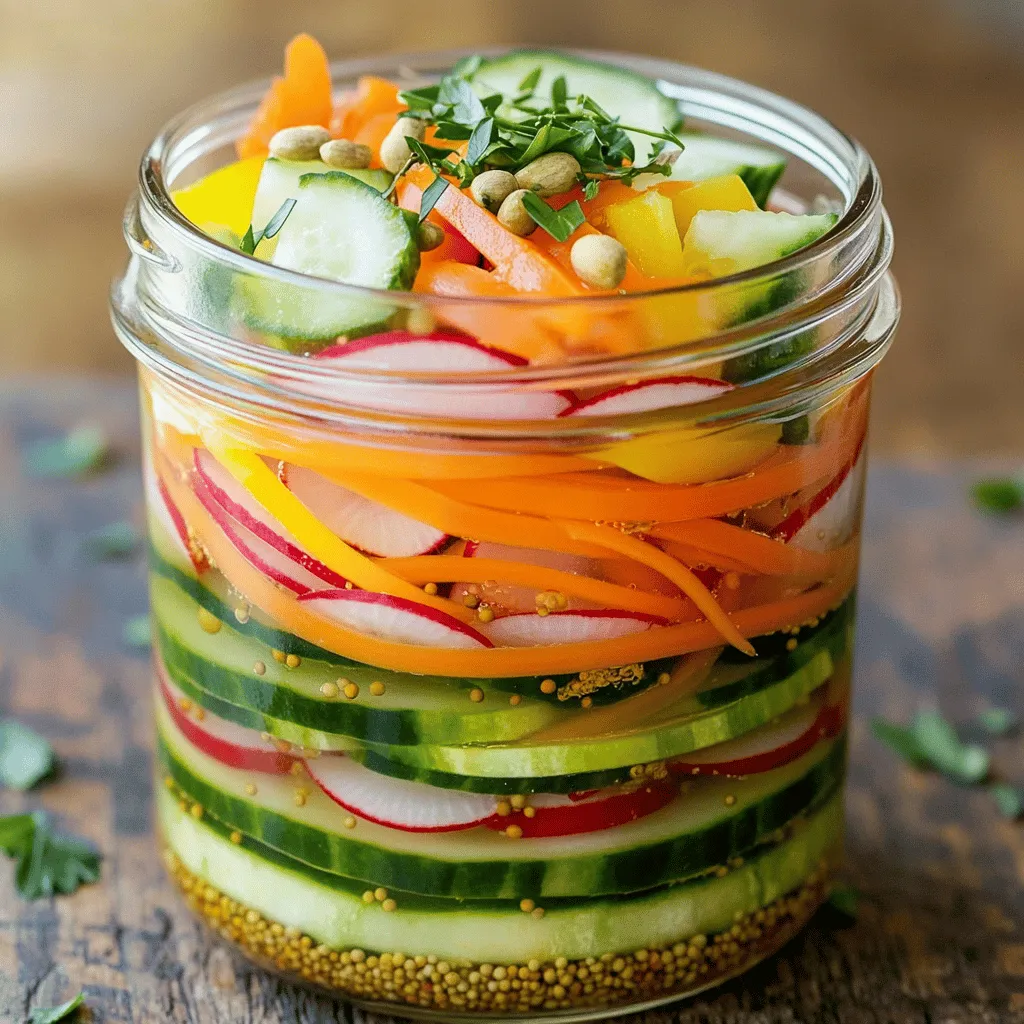Looking for a quick and easy way to elevate your meals? Let’s dive into the vibrant world of quick pickled vegetables! In just a few simple steps, you can turn fresh veggies like cucumbers and carrots into a crunchy, tangy delight. I’ll guide you through the easy process, share my favorite flavor tips, and even offer storage tricks. Get ready to add a burst of flavor to your dishes, as we pickle like pros!
Ingredients
List of Fresh Vegetables
– Cucumbers
– Carrots
– Radishes
– Bell Peppers
I love using fresh vegetables for pickling. They add crunch and color to any dish. Here’s a quick list of my favorites:
– Cucumbers: They stay crisp and refreshing.
– Carrots: Their sweetness shines through the brine.
– Radishes: They bring a delightful bite.
– Bell Peppers: Use any color you like for a fun look.
Pickling Liquid Components
– Water
– Apple Cider Vinegar
– Granulated Sugar
– Sea Salt
The pickling liquid is key to flavor. Here’s what you need:
– Water: It helps balance the taste.
– Apple Cider Vinegar: This adds tang.
– Granulated Sugar: It gives a hint of sweetness.
– Sea Salt: This brings out the flavors.
Additional Flavor Enhancers
– Mustard Seeds
– Coriander Seeds
– Garlic
– Red Pepper Flakes
To make the pickles pop, I add some spices:
– Mustard Seeds: They add a subtle warmth.
– Coriander Seeds: They give a fresh, citrusy note.
– Garlic: It enhances the overall taste.
– Red Pepper Flakes: Adjust the heat to your liking.
For the full recipe, check out the Zesty Quick Pickled Veggies 🥒.
Step-by-Step Instructions
Preparing the Pickling Brine
First, gather your ingredients. You need water, apple cider vinegar, granulated sugar, and sea salt. In a medium saucepan, combine these four ingredients. Heat the mixture over medium heat. Stir until the sugar and salt dissolve completely. This process takes about 2-3 minutes.
Adding Flavor
Once dissolved, it’s time to add flavor. Incorporate mustard seeds, smashed garlic, and red pepper flakes into the brine. Allow this mixture to come to a gentle simmer. Simmer for just 1-2 minutes. This step enhances the taste and brings out the spices.
Packing the Vegetables
Now, prepare your fresh vegetables. Take a large, heatproof jar or container. Arrange the sliced cucumbers, shredded carrots, radishes, and bell peppers inside. Aim for a colorful mix to make it visually appealing. Pour the warm pickling brine over the vegetables. Make sure all veggies are submerged. If some float, press them down gently.
Cooling and Storing
Next, let the jar cool to room temperature. Once cool, seal it with a lid. Place the jar in the refrigerator for at least 2 hours. For the best flavor, let it sit overnight. This allows all the tastes to meld together. Enjoy the crunch and tang of your quick pickled veggies! For the full recipe, refer to the provided details.
Tips & Tricks
Picking the Best Vegetables
Choose fresh vegetables that are in season. Seasonal veggies taste better and are often cheaper. For the best crunch, select firm and crisp vegetables. Cucumbers, carrots, radishes, and bell peppers work great for quick pickling. They hold their shape well and absorb flavors nicely.
Adjusting the Flavor Profile
You can change the spice level to fit your taste. Add more or fewer red pepper flakes. If you want it sweeter, increase the granulated sugar. You can also mix in spices like ginger or turmeric for a unique twist. Experiment with what you like best.
Presentation Tips
Serve the quick pickled veggies in their jar to show off their colors. This makes a fun centerpiece at any meal. Add a sprinkle of fresh herbs like dill or parsley on top. This adds a pop of color and flavor. Pair these zesty pickles with grilled meats, salads, or sandwiches for a tasty touch.
For the full recipe, check out the Zesty Quick Pickled Veggies section.

Variations
Exploring Different Vegetables
You can pick a wide range of veggies for quick pickling. Some great choices are:
– Cauliflower
– Green beans
– Zucchini
– Onions
These options add unique flavors and colors. You can even mix different vegetables for a fun salad.
Seasonal veggies can also inspire your pickling. In summer, use fresh cucumbers and peppers. In fall, try carrots and radishes. Each season brings its own twist to your pickled mix.
Flavored Pickling Liquids
The pickling liquid is key to great flavor. While apple cider vinegar works well, you can try different vinegars. Some options include:
– White wine vinegar
– Rice vinegar
– Red wine vinegar
These can change the taste of your pickles. You can also add herbs and spices to the brine for more flavor. Some favorites are:
– Dill
– Thyme
– Bay leaves
Adding these can make your pickles even more special.
Quick vs. Traditional Pickling
Quick pickling is fast and easy. It usually takes just a few hours. You heat the brine, pour it over the veggies, and let it sit.
Traditional pickling takes longer. It can take days or weeks. This method often deepens the flavor but requires more patience.
In terms of taste, quick pickles are fresh and bright. Traditional pickles have a stronger, more complex flavor. Both styles are delicious and worth trying. For a detailed recipe, check out the Full Recipe.
Storage Info
Best Practices for Storage
Store your quick pickled vegetables in a clean glass jar. I prefer using mason jars for their tight seal. Make sure your jar is large enough to hold all the veggies without crowding. This helps keep them crunchy.
Seal the jar tightly to keep out air. This is key for flavor and freshness. If using a lid, ensure it fits well. You can also use plastic wrap under the lid for extra protection.
Shelf Life of Quick Pickled Vegetables
These tangy delights last in the fridge for up to two weeks. The flavors actually get better over time. However, after a week, check for signs of spoilage.
Look for any off smells or strange colors. If the liquid looks cloudy, it’s best to throw it away. Always trust your senses when it comes to food safety.
FAQs
How long do quick pickled vegetables last?
Quick pickled vegetables can last up to two weeks in the refrigerator. They need to stay cold to keep fresh. Make sure to store them in an airtight container. Always check for any off smells or colors before eating.
Can I use other types of vinegar?
Yes, you can use other types of vinegar! White vinegar works well, and rice vinegar adds a nice touch too. Each vinegar gives a different flavor. Experiment to find what you like best.
What are the health benefits of pickled vegetables?
Pickled vegetables are rich in vitamins and minerals. They also contain probiotics, which help your gut. Eating them can improve digestion and boost your immune system. Plus, they add a tasty crunch to your meals!
Can I reuse pickling brine?
You can reuse pickling brine, but do it safely. Make sure the brine has no food bits left in it. Use it for similar vegetables only. If it smells off, throw it away. Always keep food safety in mind.
Quick pickling is a fun way to enjoy fresh vegetables. We discussed the best ingredients, like cucumbers and bell peppers, along with how to make a tasty brine. I shared tips on choosing and presenting your veggies and even explored different variations. Finally, knowing how to store your pickled creations helps keep them fresh longer. Pickling opens a world of flavors and possibilities. Enjoy your tasty, crunchy snacks!

